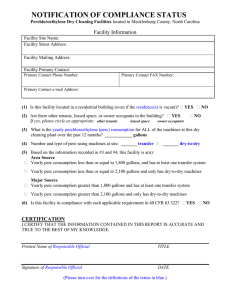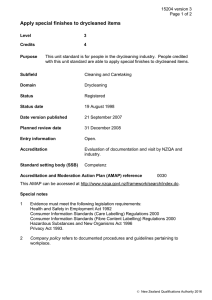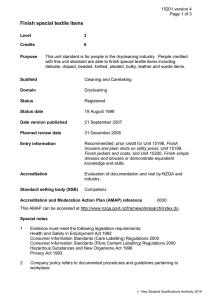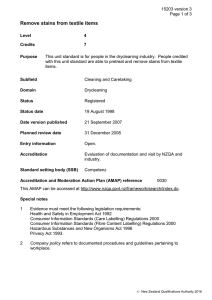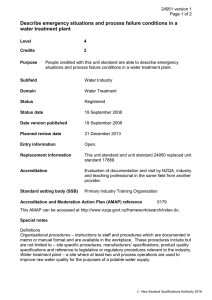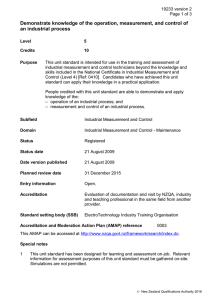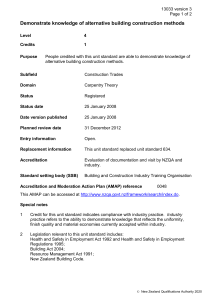Demonstrate knowledge of perchloroethylene for drycleaning
advertisement
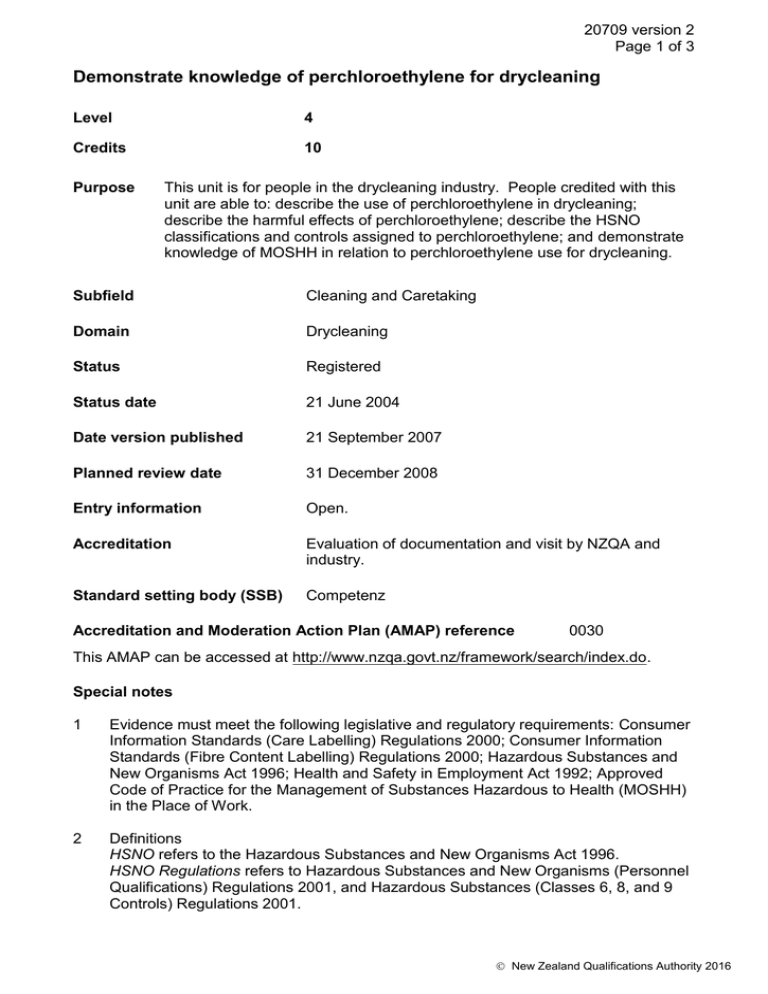
20709 version 2 Page 1 of 3 Demonstrate knowledge of perchloroethylene for drycleaning Level 4 Credits 10 Purpose This unit is for people in the drycleaning industry. People credited with this unit are able to: describe the use of perchloroethylene in drycleaning; describe the harmful effects of perchloroethylene; describe the HSNO classifications and controls assigned to perchloroethylene; and demonstrate knowledge of MOSHH in relation to perchloroethylene use for drycleaning. Subfield Cleaning and Caretaking Domain Drycleaning Status Registered Status date 21 June 2004 Date version published 21 September 2007 Planned review date 31 December 2008 Entry information Open. Accreditation Evaluation of documentation and visit by NZQA and industry. Standard setting body (SSB) Competenz Accreditation and Moderation Action Plan (AMAP) reference 0030 This AMAP can be accessed at http://www.nzqa.govt.nz/framework/search/index.do. Special notes 1 Evidence must meet the following legislative and regulatory requirements: Consumer Information Standards (Care Labelling) Regulations 2000; Consumer Information Standards (Fibre Content Labelling) Regulations 2000; Hazardous Substances and New Organisms Act 1996; Health and Safety in Employment Act 1992; Approved Code of Practice for the Management of Substances Hazardous to Health (MOSHH) in the Place of Work. 2 Definitions HSNO refers to the Hazardous Substances and New Organisms Act 1996. HSNO Regulations refers to Hazardous Substances and New Organisms (Personnel Qualifications) Regulations 2001, and Hazardous Substances (Classes 6, 8, and 9 Controls) Regulations 2001. New Zealand Qualifications Authority 2016 20709 version 2 Page 2 of 3 MOSHH refers to the Occupational Health and Safety Service, Approved Code of Practice for the Management of Substances Hazardous to Health (MOSHH) in the Place of Work (Wellington: 1997) available from h://www.osh.govt.nz/order/catalogue/327.shtml. Elements and performance criteria Element 1 Describe the use of perchloroethylene in drycleaning. Performance criteria 1.1 Properties of perchloroethylene are described in relation to textile cleaning. Range 1.2 Perchloroethylene drycleaning processes are described. Range 1.3 physical properties, chemical properties. solvent cleaning, drying, water removal, filtration, distillation. Safe handling of perchloroethylene is described. Range delivery, storage, transfer, transport, waste disposal, personal protective equipment, spill cleanup. Element 2 Describe the harmful effects of perchloroethylene. Performance criteria 2.1 The harmful effects on human health and safety are described. Range 2.2 toxicity, irritant, systemic effects, carcinogenicity. The harmful effects on the environment are described. Range air, water, land. Element 3 Describe the HSNO classifications and controls assigned to perchloroethylene. Performance criteria 3.1 Description includes HSNO hazard classifications of perchloroethylene. Range toxicity, ecotoxicity. New Zealand Qualifications Authority 2016 20709 version 2 Page 3 of 3 3.2 Description includes controls for the hazardous properties of perchloroethylene. Range 3.3 Description includes pan-life cycle controls for perchloroethylene. Range 3.4 workplace and public area exposure limits, disposal, transport, approved handlers, protective clothing. packaging, labelling, identification, sales and supply, signage, availability and access to information, tracking, emergency response management. The test certificate regime for an approved handler for perchloroethylene drycleaning is described in accordance with HSNO Regulations. Range achieving a test certificate, conditions attached to test certificate, duration of test certificate, phases of lifecycle that test certificate applies to. Element 4 Demonstrate knowledge of MOSHH in relation to perchloroethylene use for drycleaning. Performance criteria 4.1 MOSHH is described in relation to perchloroethylene drycleaning and safe practice for labelling, handling, and disposal. Please note Providers must be accredited by NZQA, or an inter-institutional body with delegated authority for quality assurance, before they can report credits from assessment against unit standards or deliver courses of study leading to that assessment. Industry Training Organisations must be accredited by NZQA before they can register credits from assessment against unit standards. Accredited providers and Industry Training Organisations assessing against unit standards must engage with the moderation system that applies to those standards. Accreditation requirements and an outline of the moderation system that applies to this standard are outlined in the Accreditation and Moderation Action Plan (AMAP). The AMAP also includes useful information about special requirements for organisations wishing to develop education and training programmes, such as minimum qualifications for tutors and assessors, and special resource requirements. Comments on this unit standard Please contact Competenz info@competenz.org.nz if you wish to suggest changes to the content of this unit standard. New Zealand Qualifications Authority 2016

